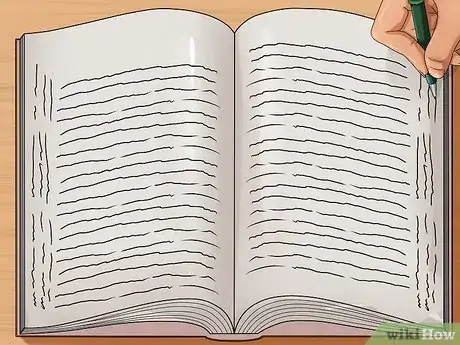This article was co-authored by Michelle Golden, PhD. Michelle Golden is an English teacher in Athens, Georgia. She received her MA in Language Arts Teacher Education in 2008 and received her PhD in English from Georgia State University in 2015.
wikiHow marks an article as reader-approved once it receives enough positive feedback. In this case, 96% of readers who voted found the article helpful, earning it our reader-approved status.
This article has been viewed 89,478 times.
Reading a textbook can often feel like a daunting task. The language can be dry and there can be many unknown words and phrases. You may feel overwhelmed by the very number of pages that you have been assigned to read. However, there are ways that you can become more comfortable with your textbook and more confident in reading it.
Steps
Getting To Know Your Textbook
-
1Look at the cover. Are there pictures or art that can give you a clue on the topics you may be studying? What about the title? Is this a book for beginners or for someone with more skill?
- Use the title for a more specific idea on the course. If it's a history book, will you be studying World History or Early American History? What do you already know about this subject?
- What about the authors, publisher and publishing date? Is this an old book or is it pretty current?
-
2Review the table of contents, index, and glossary. How many chapters does the textbook have, and about how long are they? What about sub-chapters? What are the titles of the chapters and sub-chapters?
- Is there a glossary or a series of appendices? What about a bibliography? What types of words does the index have in it?
Advertisement -
3Skim the textbook for headlines and visuals. Quickly flip through the pages. What immediately catches your attention? Take note of the chapter titles, bold words and vocabulary, photos, drawings, charts and diagrams. What do they tell you about things you'll be learning in the book?
- You can also skim to evaluate the difficulty of reading level for the text. Select one random page that is mostly text (not many visuals) and read it for comprehension. Time how long it takes you to read it.
Reading Actively
-
1Read the end of the chapter first. That's right. Go to the end of the chapter, and read the summary and the questions that are there. This is the perfect way to for you to get an idea of what you're about to read in the chapter. It will prep your brain and help it to sift through and make sense of all the more detailed information that's in the actual chapter.
- Next, read the introduction to the chapter. This also helps your brain get ready for the onslaught of information and helps it with processing.[1]
-
2Divide your assignment into 10 page chunks. After each chunk, go back and look at your highlights, your margin notes, and your notebook notes. This will help you with longer term memory of what was read.
- Complete the next steps in this section using the 10 page chunk recommendation. When you've finished 10 pages and briefly reviewed them, begin the next 10 pages. Or, take a quick break and then resume working on the next 10 pages.[2]
-
3Highlight your own textbook. If you purchased the book (and you're not borrowing it from a person, library, or school), you should highlight. There is a specific way to do this correctly, so keep the following in mind:
- Don't stop to highlight or take notes during the first reading. This disrupts your flow of comprehension, and you may end up highlighting things that you shouldn't.
- Wait until you have read an entire paragraph or a whole short section (depending on how the sections are broken up) to go back and highlight. This way, you will know what is important enough to highlight.
- Don't highlight single words (too little) or entire sentences (too much). Keep it down to one or two highlighted phrases per paragraph. The idea of highlighting is that you should be able to glance at the highlighted phrases a month later and get the gist of what you read without having to re-read the whole thing.[3]
-
4Write questions in the margins. In your margins, (or on a post-it note if it is not your book that you bought), jot down one or two questions per paragraph or section that you should be able to answer from reading that paragraph or section. This could be “What years were considered the Renaissance?” or “What is the meaning of metamorphosis?”
- After you have read the whole assignment, you should go back and try to answer these questions without re-reading.
-
5Take notes. In a notebook for the class, jot down the main ideas of what you read for each section, IN YOUR OWN WORDS. It is extremely important to write your notes in your own words.
- Writing your notes in your own words helps you avoid plagiarism if you have to write a paper, and you will be confident that you really comprehended something if your notes are not directly copied from the textbook.[4]
-
6Bring your notes and questions to class. This will help you feel prepared for class discussions or lectures associated with the text. Be sure to pay attention and participate during class, and write additional notes! Your instructor may tell you if tests are based mostly on the book or on lectures, but sometimes they don't tell you and it's best to be prepared for anything.
Scheduling Time to Read, Review, and Study
-
1Multiply the number of pages in your assignment by 5 minutes. This is the time it takes an average college student to read the pages of a textbook. Keep this in mind as you schedule time for your reading.
- For instance, if you have to read 73 pages for an assignment, that is 365 minutes, or approximately six hours of reading.[5]
-
2Give yourself breaks. If you calculate that you have four hours of reading, we don't recommend trying to do all of it at one time. You may become tired and unfocused.
- Read for an hour at your lunch break, an hour in the evening, etc. Try to spread it out a bit, taking into consideration how many days you have to complete the assigned number of pages and the hours it will take you to read them.[6]
-
3Read each day. If you fall behind, you will find yourself skimming and speed-reading, which causes you to miss important information. Schedule some time to read each day so you can chip away at the assignment slowly and less stressfully.[7]
-
4Read in a distraction-free zone. This is very important. You can't be expected to comprehend lots of information if there is noise around.
- Avoid reading in your bed if possible. Your brain most likely associates your bed with sleep, and it will want to do that if you are reading there. Sleep experts also say that doing “work” in bed can lead to sleeping problems, and only relaxing reading and activities should be done in bed so you don't start having a hard time falling and staying asleep.
- Go to a quiet room in your house, the library, a quiet coffee shop, or a park to read. Anywhere that has little distractions for you is best. If you have a family (or roommates) or have lots of responsibilities at home, go out. If having any people around at all distracts you, but your home is fairly quiet, stay in. Whatever works for you; you may have to experiment and see where you can study best.[8]
-
5Understand what you will be assessed on. Are you being asked to write a paper, or do you have a big test that covers the assigned material? If there is a test, did the instructor offer a study guide? Take all of this into account as you focus on what you should spend the most time reviewing while you study.
-
6Read your notes multiple times. If you read carefully, highlighted and took notes, you should only need to read the textbook once. What you will re-read during studying is your highlighted phrases, your margin questions and/or notes, and your notebook notes.
- Read these as many times as necessary to fully understand the material. If you didn't take great notes, you may need to re-read.[9]
-
7Talk to others about what you're studying. Studies show that there are huge benefits to talking out loud about what you are learning.
- Form study groups with your classmates, or talk with someone at home or another friend about what you are reading.
- Be sure to attend all of your classes, not just on test days or days that papers are due. Most likely there are discussions or lectures happening about the textbook material, and these are extremely beneficial to your long-term learning of the readings.[10]
-
8Complete all of the work assigned. If the instructor gave you math exercises to complete, or short answer questions to write, but they aren't necessarily graded, do them anyway. There is a purpose to the assigning of the work, and that is for you to further your understanding of the material from the book.
Community Q&A
-
QuestionHow do I read faster and still absorb the material?
 Community AnswerYou could try reading texts and paragraphs where you don't need to absorb every detail. Target a time for each page and after reading the page within that time, question yourself on what happened in that page. if you practice this method you could read faster and still absorb the material.
Community AnswerYou could try reading texts and paragraphs where you don't need to absorb every detail. Target a time for each page and after reading the page within that time, question yourself on what happened in that page. if you practice this method you could read faster and still absorb the material. -
QuestionHow can I behave in class so that everyone likes me?
 Community AnswerYou should show gentle and nice behavior towards your class fellows. Complete your class work. Respect your teacher and obey him/her. If you have a student proctor then obey his/her orders. Also, don't talk too much.
Community AnswerYou should show gentle and nice behavior towards your class fellows. Complete your class work. Respect your teacher and obey him/her. If you have a student proctor then obey his/her orders. Also, don't talk too much. -
QuestionCan this method work for a self taught student?
 TorpiTop AnswererYes, this mostly applies to self-taught students as well. The only parts that don't apply is bringing the book to class and asking the teacher questions.
TorpiTop AnswererYes, this mostly applies to self-taught students as well. The only parts that don't apply is bringing the book to class and asking the teacher questions.
References
- ↑ http://www.studyright.net/blog/4-steps-to-reading-a-textbook-quickly-and-effectively/
- ↑ http://www.cornellcollege.edu/academic-support-and-advising/study-tips/reading-textbooks.shtml
- ↑ http://www.cornellcollege.edu/academic-support-and-advising/study-tips/reading-textbooks.shtml
- ↑ http://www.cornellcollege.edu/academic-support-and-advising/study-tips/reading-textbooks.shtml
- ↑ http://www.cornellcollege.edu/academic-support-and-advising/study-tips/reading-textbooks.shtml
- ↑ http://www.cornellcollege.edu/academic-support-and-advising/study-tips/reading-textbooks.shtml
- ↑ http://www.baylor.edu/support_programs/index.php?id=42443
- ↑ http://www.baylor.edu/support_programs/index.php?id=42443
- ↑ http://www.studyright.net/blog/4-steps-to-reading-a-textbook-quickly-and-effectively/
About This Article
Before you begin reading, take a few minutes and look over your textbook, paying attention to the cover, table of contents, and index. Try to get a sense of the book's main topics and how it is organized. When tackling assigned reading, break up your reading into 10-page chunks and plan to read for no more than 1 hour at a time. As you read, take notes on main ideas. Go back and highlight important phrases after deciding which keywords or phrases are important. For more on developing strong studying habits from our reviewer, keep scrolling!














































































